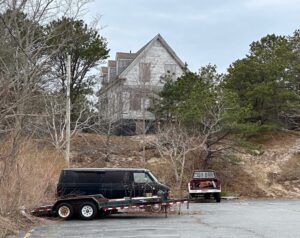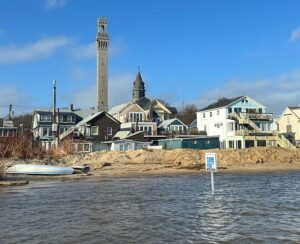PROVINCETOWN — Every year in May, after town meeting and the annual town election, the select board scores the town manager’s progress and writes a new set of “goals and deliverables” for the year to come.

Because the town manager’s annual raise is linked to that score, the list of goals is a reliable guide to where town staff will direct their attention. Planning for changes at the police and fire depts. were key goals last year, for example, and the board gave Town Manager Alex Morse high marks on May 27 for his efforts to reorganize the fire department and for hiring Police Chief Greg Hennick.
“I came early for the police chief’s swearing in and talked with a group of officers, and they were all smiling,” said select board member Leslie Sandberg. “How you handled that — and how you handled yourself when you were getting slings and arrows during the change in culture and structure of the fire dept. — was outstanding.”
The board approved a 3-percent raise for Morse, the highest allowed by his contract. His salary had been $220,000, Morse told the Independent; the 3-percent raise and a 2-percent cost of living adjustment will make it $231,000.
Goals for Next Year
On the housing front, the town will help with the lottery for the 65 affordable units being built at 3 Jerome Smith Road and will plan a lottery for 30 more affordable-ownership units that should be underway by next year at 26 Shank Painter Road. The town will also hold community engagement sessions to begin planning new housing at 288A Bradford St. and 22 Nelson Ave. and look for grants that could bring the expanding sewer system out to Nelson Avenue after a wastewater substation is built near the town cemetery in 2028.

According to the new goals, town staff are also supposed to define two large parcels in the town-owned right-of-way around Route 6. Although a 1.4-acre developable area was identified south of the highway and west of the town’s dog park in March 2024, along with a 3-acre area north of the highway where it intersects Howland Street, neither area has been surveyed into actual parcels yet.
Two other planning goals intersect with housing: a comprehensive zoning study to update the town’s bylaws and a derelict properties bylaw that could help spur the redevelopment of properties that have sat vacant for years.
One such property, select board members said, was the group of decaying buildings at 39 Ship’s Way, some of which are visible from the parking lots of Stop & Shop and Mac’s Fish House.
There are nine houses at 39 Ship’s Way with 22 units — nearly as many as at the town-owned Harbor Hill apartments. In 2020, Provincetown Water Supervisor Cody Salisbury confirmed there had been no water usage at any of those units in many years.
“I call it Grey Gardens,” Sandberg said of the property.
Morse said some communities require owners of vacant properties to pay an annual registration fee.
Depending on how the bylaw is written, it could also apply to the former Old Reliable building at 227R Commercial St., Abramson said.
To address coastal flooding, the town’s number-two priority, staff is supposed to work toward stormwater drainage projects in the East End and begin a feasibility study for an offshore wave attenuator there.
The town is also supposed to secure permits for and install a long-delayed dune to protect the area around town hall from flooding. That project has been delayed by uncertainty about how many easements the town needs to secure from nearby property owners, as well as uncertainty about how much the town should offer to pay for those easements, Community Development Director Tim Famulare has reported.
“The easiest way to get those easements is to stop putting up the dune” that the DPW installs every winter, Abramson joked.
Two new assignments for town staff are in the “roadway safety” goal, including a plan for raised crosswalks on Bradford Street. Select board member Austin Miller has said that since small electric vehicles including scooters and skateboards cannot legally travel both ways on Commercial Street, traffic on Bradford Street needs to be slower and safer. A plan for raised crosswalks and other traffic calming features is expected at town meeting in 2026.
Another new goal is already in the works, Assistant Town Manager Dan Riviello said: deployable shields that can block a vehicle from driving through crowds on Commercial Street.
“The city of Boston used these at their St. Patrick’s Day parade for the first time this year, and they really liked them,” Riviello said. “They’re massive metal barriers that you can move with a hand cart, but they can stop a car going 40 or 50 miles an hour dead in its tracks.”
Miller and Sandberg said they had often worried about vehicle attacks on Commercial Street.
Under former Police Chief Jim Golden, the town was “opening up vehicle traffic before the Carnival parade was even over — there were massive crowds and cars coming down the street,” Morse said. The police will start closing Commercial Street to vehicles on busy summer evenings, he added.
The board also added goals related to public health: coordinating with other towns on health care planning and making an assessment of federal funding cuts.
“A lot of towns have been putting money toward housing in different communities, and I think we need to take that model and put something together for our human services and Outer Cape Health,” said Sandberg.
Town staff need to assess federal funding cuts, including to health care and infrastructure programs, and make a plan for how to maintain services, Abramson said.



